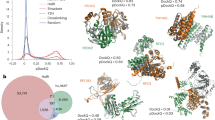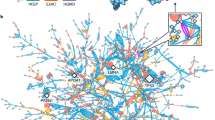Abstract
To better understand the molecular mechanisms and genetic basis of human disease, we systematically examine relationships between 3,949 genes, 62,663 mutations and 3,453 associated disorders by generating a three-dimensional, structurally resolved human interactome. This network consists of 4,222 high-quality binary protein-protein interactions with their atomic-resolution interfaces. We find that in-frame mutations (missense point mutations and in-frame insertions and deletions) are enriched on the interaction interfaces of proteins associated with the corresponding disorders, and that the disease specificity for different mutations of the same gene can be explained by their ___location within an interface. We also predict 292 candidate genes for 694 unknown disease-to-gene associations with proposed molecular mechanism hypotheses. This work indicates that knowledge of how in-frame disease mutations alter specific interactions is critical to understanding pathogenesis. Structurally resolved interaction networks should be valuable tools for interpreting the wealth of data being generated by large-scale structural genomics and disease association studies.
This is a preview of subscription content, access via your institution
Access options
Subscribe to this journal
Receive 12 print issues and online access
209,00 € per year
only 17,42 € per issue
Buy this article
- Purchase on SpringerLink
- Instant access to full article PDF
Prices may be subject to local taxes which are calculated during checkout




Similar content being viewed by others
References
Pasternak, J. An Introduction to Human Molecular Genetics, edn. 2 (Wiley, Hoboken, NJ, 2005).
Goh, K.I. et al. The human disease network. Proc. Natl. Acad. Sci. USA 104, 8685–8690 (2007).
Dermitzakis, E.T. & Clark, A.G. Genetics. Life after GWA studies. Science 326, 239–240 (2009).
Yildirim, M.A., Goh, K.I., Cusick, M.E., Barabasi, A.L. & Vidal, M. Drug-target network. Nat. Biotechnol. 25, 1119–1126 (2007).
Rual, J.F. et al. Towards a proteome-scale map of the human protein-protein interaction network. Nature 437, 1173–1178 (2005).
Stelzl, U. et al. A human protein-protein interaction network: a resource for annotating the proteome. Cell 122, 957–968 (2005).
Venkatesan, K. et al. An empirical framework for binary interactome mapping. Nat. Methods 6, 83–90 (2009).
Yu, H. et al. Next-generation sequencing to generate interactome datasets. Nat. Methods 8, 478–480 (2011).
Feldman, I., Rzhetsky, A. & Vitkup, D. Network properties of genes harboring inherited disease mutations. Proc. Natl. Acad. Sci. USA 105, 4323–4328 (2008).
Keshava Prasad, T.S. et al. Human Protein Reference Database–2009 update. Nucleic Acids Res. 37, D767–D772 (2009).
Breitkreutz, B.J. et al. The BioGRID Interaction Database: 2008 update. Nucleic Acids Res. 36, D637–D640 (2008).
Aranda, B. et al. The IntAct molecular interaction database in 2010. Nucleic Acids Res. 38, D525–D531 (2010).
Ceol, A. et al. MINT, the molecular interaction database: 2009 update. Nucleic Acids Res. 38, D532–D539 (2010).
Hu, Z. et al. VisANT 3.5: multi-scale network visualization, analysis and inference based on the gene ontology. Nucleic Acids Res. 37, W115–W121 (2009).
Turner, B. et al. iRefWeb: interactive analysis of consolidated protein interaction data and their supporting evidence. Database (Oxford) 2010, baq023 (2010).
Kim, P.M., Lu, L.J., Xia, Y. & Gerstein, M.B. Relating three-dimensional structures to protein networks provides evolutionary insights. Science 314, 1938–1941 (2006).
Finn, R.D., Marshall, M. & Bateman, A. iPfam: visualization of protein-protein interactions in PDB at ___domain and amino acid resolutions. Bioinformatics 21, 410–412 (2005).
Stein, A., Panjkovich, A. & Aloy, P. 3did Update: ___domain-___domain and peptide-mediated interactions of known 3D structure. Nucleic Acids Res. 37, D300–D304 (2009).
Berman, H.M. et al. The Protein Data Bank. Nucleic Acids Res. 28, 235–242 (2000).
Yu, H. et al. High-quality binary protein interaction map of the yeast interactome network. Science 322, 104–110 (2008).
Cusick, M.E. et al. Literature-curated protein interaction datasets. Nat. Methods 6, 39–46 (2009).
Turinsky, A.L., Razick, S., Turner, B., Donaldson, I.M. & Wodak, S.J. Literature curation of protein interactions: measuring agreement across major public databases. Database (Oxford) 2010, baq026 (2010).
Amberger, J., Bocchini, C.A., Scott, A.F. & Hamosh, A. McKusick's Online Mendelian Inheritance in Man (OMIM). Nucleic Acids Res. 37, D793–D796 (2009).
Stenson, P.D. et al. The Human Gene Mutation Database: 2008 update. Genome Med. 1, 13 (2009).
Yu, H., Jansen, R., Stolovitzky, G. & Gerstein, M. Total ancestry measure: quantifying the similarity in tree-like classification, with genomic applications. Bioinformatics 23, 2163–2173 (2007).
Zhong, Q. et al. Edgetic perturbation models of human inherited disorders. Mol. Syst. Biol. 5, 321 (2009).
Schuster-Bockler, B. & Bateman, A. Protein interactions in human genetic diseases. Genome Biol. 9, R9 (2008).
Ferrer-Costa, C., Orozco, M. & de la Cruz, X. Characterization of disease-associated single amino acid polymorphisms in terms of sequence and structure properties. J. Mol. Biol. 315, 771–786 (2002).
Smigielski, E.M., Sirotkin, K., Ward, M. & Sherry, S.T. dbSNP: a database of single nucleotide polymorphisms. Nucleic Acids Res. 28, 352–355 (2000).
The 1000 Genomes Project Consortium. A map of human genome variation from population-scale sequencing. Nature 467, 1061–1073 (2010).
Peltomaki, P. & Vasen, H.F. Mutations predisposing to hereditary nonpolyposis colorectal cancer: database and results of a collaborative study. The International Collaborative Group on Hereditary Nonpolyposis Colorectal Cancer. Gastroenterology 113, 1146–1158 (1997).
Thrasher, A.J. & Burns, S.O. WASP: a key immunological multitasker. Nat. Rev. Immunol. 10, 182–192 (2010).
Kim, A.S., Kakalis, L.T., Abdul-Manan, N., Liu, G.A. & Rosen, M.K. Autoinhibition and activation mechanisms of the Wiskott-Aldrich syndrome protein. Nature 404, 151–158 (2000).
Higgs, H.N. & Pollard, T.D. Activation by Cdc42 and PIP(2) of Wiskott-Aldrich syndrome protein (WASp) stimulates actin nucleation by Arp2/3 complex. J. Cell Biol. 150, 1311–1320 (2000).
Moulding, D.A. et al. Unregulated actin polymerization by WASp causes defects of mitosis and cytokinesis in X-linked neutropenia. J. Exp. Med. 204, 2213–2224 (2007).
Ancliff, P.J. et al. Two novel activating mutations in the Wiskott-Aldrich syndrome protein result in congenital neutropenia. Blood 108, 2182–2189 (2006).
Oliver, S. Guilt-by-association goes global. Nature 403, 601–603 (2000).
Wang, X., Gulbahce, N. & Yu, H. Network-based methods for human disease gene prediction. Brief Funct. Genomics 10, 280–293 (2011).
Oti, M., Snel, B., Huynen, M.A. & Brunner, H.G. Predicting disease genes using protein-protein interactions. J. Med. Genet. 43, 691–698 (2006).
Noris, M. & Remuzzi, G. Atypical hemolytic-uremic syndrome. N. Engl. J. Med. 361, 1676–1687 (2009).
Yang, A. et al. p63, a p53 homolog at 3q27–29, encodes multiple products with transactivating, death-inducing, and dominant-negative activities. Mol. Cell 2, 305–316 (1998).
Bougeard, G., Hadj-Rabia, S., Faivre, L., Sarafan-Vasseur, N. & Frebourg, T. The Rapp-Hodgkin syndrome results from mutations of the TP63 gene. Eur. J. Hum. Genet. 11, 700–704 (2003).
Harada, B.T. et al. Regulation of enzyme localization by polymerization: polymer formation by the SAM ___domain of diacylglycerol kinase delta1. Structure 16, 380–387 (2008).
Bamshad, M.J. et al. Exome sequencing as a tool for Mendelian disease gene discovery. Nat. Rev. Genet. 12, 745–755 (2011).
Chandonia, J.M. & Brenner, S.E. The impact of structural genomics: expectations and outcomes. Science 311, 347–351 (2006).
Neduva, V. et al. Systematic discovery of new recognition peptides mediating protein interaction networks. PLoS Biol. 3, e405 (2005).
Chi, S.W., Ayed, A. & Arrowsmith, C.H. Solution structure of a conserved C-terminal ___domain of p73 with structural homology to the SAM ___domain. EMBO J. 18, 4438–4445 (1999).
Clore, G.M. et al. Refined solution structure of the oligomerization ___domain of the tumour suppressor p53. Nat. Struct. Biol. 2, 321–333 (1995).
Hwang, D. et al. A systems approach to prion disease. Mol. Syst. Biol. 5, 252 (2009).
Vidal, M., Cusick, M.E. & Barabasi, A.L. Interactome networks and human disease. Cell 144, 986–998 (2011).
The UniProt Consortium. The Universal Protein Resource (UniProt). Nucleic Acids Res. 35, D193–D197 (2007).
Finn, R.D. et al. The Pfam protein families database. Nucleic Acids Res. 38, D211–D222 (2010).
Prieto, C. & De Las Rivas, J. Structural ___domain-___domain interactions: assessment and comparison with protein-protein interaction data to improve the interactome. Proteins 78, 109–117 (2010).
Whitfield, M.L. et al. Identification of genes periodically expressed in the human cell cycle and their expression in tumors. Mol. Biol. Cell 13, 1977–2000 (2002).
Su, A.I. et al. Large-scale analysis of the human and mouse transcriptomes. Proc. Natl. Acad. Sci. USA 99, 4465–4470 (2002).
Bar-Joseph, Z. et al. Genome-wide transcriptional analysis of the human cell cycle identifies genes differentially regulated in normal and cancer cells. Proc. Natl. Acad. Sci. USA 105, 955–960 (2008).
Irizarry, R.A. et al. Exploration, normalization, and summaries of high density oligonucleotide array probe level data. Biostatistics 4, 249–264 (2003).
Smyth, G.K. & Speed, T. Normalization of cDNA microarray data. Methods 31, 265–273 (2003).
Johnson, W.E., Li, C. & Rabinovic, A. Adjusting batch effects in microarray expression data using empirical Bayes methods. Biostatistics 8, 118–127 (2007).
Ashburner, M. et al. Gene ontology: tool for the unification of biology. The Gene Ontology Consortium. Nat. Genet. 25, 25–29 (2000).
Lamesch, P. et al. hORFeome v3.1: a resource of human open reading frames representing over 10,000 human genes. Genomics 89, 307–315 (2007).
Suzuki, Y. et al. A novel high-throughput (HTP) cloning strategy for site-directed designed chimeragenesis and mutation using the Gateway cloning system. Nucleic Acids Res. 33, e109 (2005).
Acknowledgements
This work was supported by the Startup Fund from Cornell University (to H.Y.), National Cancer Institute R01 CA098626 (to S.M.L.), R21 CA122937 (to S.M.L.) and a generous donation by M. Bell (to S.M.L.). J.D. is supported by the Tata Graduate Fellowship. We thank A. Paccanaro, K. Salehi-Ashtiani, M.A. Yildirim and the anonymous reviewers for critical reading and constructive comments of the manuscript.
Author information
Authors and Affiliations
Contributions
H.Y. conceived the study, designed all analyses and oversaw all aspects of the project. X. Wang and B.T. performed all computational analyses, interpreted the results and prepared all figures with J.D.'s help. B.T. and J.D. designed the supplementary website. X. Wei, S.M.L. and H.Y. designed all experiments. X. Wei did all experiments and interpreted the results. H.Y. wrote the manuscript with contributions from all authors. X. Wang and B.T. wrote the supplementary materials. X. Wei wrote all parts related to the background, interpretations and discussion of the experimental results and protocols.
Corresponding author
Ethics declarations
Competing interests
The authors declare no competing financial interests.
Supplementary information
Supplementary Text and Figures
Supplementary Notes 1–17 and Supplementary Figs. 1–25 (PDF 4048 kb)
Supplementary Table 1
List of evidence codes representing binary protein-protein interactions (XLSX 12 kb)
Supplementary Table 2
Binary interactions of the human protein interactome (XLSX 326 kb)
Supplementary Table 3
Structurally resolved human interactome (XLSX 2800 kb)
Supplementary Table 4
List of disease gene predictions (XLSX 26 kb)
Supplementary Table 5
Enrichment in co-expressed and functionally similar protein-protein interaction pairs (XLSX 41 kb)
Supplementary Table 6
Sample size in the calculations (XLSX 41 kb)
Supplementary Table 7
List of primers (XLSX 12 kb)
Supplementary Table 8
Diseases and their associated genes curated from OMIM and HGMD (XLSX 637 kb)
Supplementary Table 9
In-frame indels enriched on interaction interfaces (XLSX 68 kb)
Supplementary Table 10
Missense point mutations enriched on interaction interfaces (XLSX 157 kb)
Supplementary Table 11
SNPs on interaction interfaces of human structural interactome (XLSX 465 kb)
Rights and permissions
About this article
Cite this article
Wang, X., Wei, X., Thijssen, B. et al. Three-dimensional reconstruction of protein networks provides insight into human genetic disease. Nat Biotechnol 30, 159–164 (2012). https://doi.org/10.1038/nbt.2106
Received:
Accepted:
Published:
Issue Date:
DOI: https://doi.org/10.1038/nbt.2106
This article is cited by
-
My personal mutanome: a computational genomic medicine platform for searching network perturbing alleles linking genotype to phenotype
Genome Biology (2021)
-
Removing auto-activators from yeast-two-hybrid assays by conditional negative selection
Scientific Reports (2021)
-
Comprehensive characterization of protein–protein interactions perturbed by disease mutations
Nature Genetics (2021)
-
Genetics of extreme human longevity to guide drug discovery for healthy ageing
Nature Metabolism (2020)
-
ARD-PRED: an in silico tool for predicting age-related-disorder-associated proteins
Soft Computing (2019)



